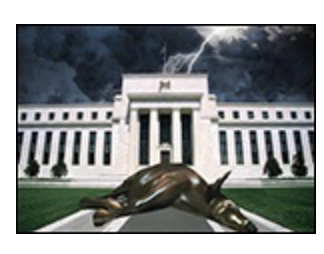Courtesy of Pam Martens
 Federal Reserve Chairman Jerome Powell’s oft repeated mantra this year – that the behemoth Wall Street banks “are a source of strength” in this economic crisis – is melting away faster than a snow cone in July, along with the share prices of these banks. So whom should Americans believe: The composite wisdom of the market or the opinion of a federal regulator whose supervision of these banks has been far from stellar.
Federal Reserve Chairman Jerome Powell’s oft repeated mantra this year – that the behemoth Wall Street banks “are a source of strength” in this economic crisis – is melting away faster than a snow cone in July, along with the share prices of these banks. So whom should Americans believe: The composite wisdom of the market or the opinion of a federal regulator whose supervision of these banks has been far from stellar.
The market would seem to have spoken clearly on just how “strong” these banks are. Since the first trading day of the year, January 2, to yesterday’s closing price, here’s the factual reality of just how much common equity capital these banks have bled: Citigroup is down a stunning 48 percent, losing almost half of its common equity capital; Bank of America has lost 35 percent; while JPMorgan Chase, the bank that has perpetually bragged about its “fortress balance sheet,” is down 34 percent year-to-date. And the U.S. is only seven months into what could become a prolonged economic downturn.
The reason Powell has to tippy toe around the Wall Street mega banks’ condition is because, as of June 30 according to the Federal Deposit Insurance Corporation (FDIC), Citigroup is sitting on $1.2 trillion of deposits, of which half are foreign and might take flight; Bank of America is sitting on $1.8 trillion in deposits, of which 94 percent are U.S. based; and JPMorgan Chase holds $2 trillion in deposits, of which $1.7 trillion or 85 percent are U.S. based.
As of September 10, the FDIC reports that the U.S. had 5,059 federally insured institutions including banks and savings associations. The three banks named above are holding 30 percent of all deposits held by all 5,059 federally insured financial institutions in the U.S. while representing just 0.059 percent of the number of federally insured institutions.
The 5,059 banks we have today is less than half of the 10,220 banks and savings associations that were federally insured at the end of 1999 – the year that the Bill Clinton administration passed the Gramm-Leach-Bliley Act that repealed the 1933 Glass-Steagall Act. The repeal of the Glass-Steagall Act, which had protected the U.S. financial system brilliantly for 66 years, meant that Wall Street’s casino investment banks were now unleashed to gobble up federally insured banks. And gobble them up is exactly what they did.
By the end of 2005, six years after the Clinton administration had repealed the Glass-Steagall Act, the U.S. was down to 8,832 federally insured banking institutions. By 2010, the number of U.S. banking institutions had dropped to 7,657 with 197 institutions absorbed that year through mergers. In years 2015, 2016 and 2017, there were a total of 786 federally insured banking institutions absorbed through mergers.
…



